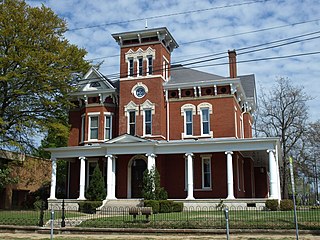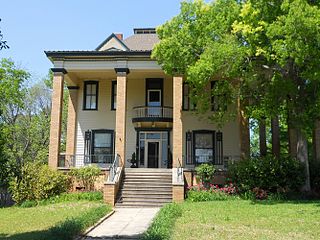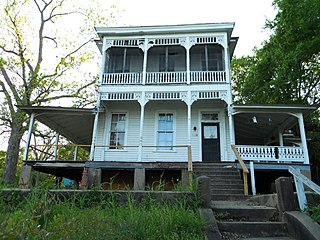
This is a list of the National Register of Historic Places listings in Limestone County, Alabama.

The Bray-Barron House is a historic house in Eufaula, Alabama, U.S.. It was built prior to 1850 for Nathan Bray, who went on to serve in the Confederate States Army during the American Civil War of 1861-1865 alongside his three brothers. The house remained in the family until 1963. It was purchased by N. G. Barron and his wife Ruby Hutton Barron in 1965. It has been listed on the National Register of Historic Places since May 27, 1971.

The Kiels-McNab House is a historic house located on west Washington Street in Eufaula, Alabama.

The Guild-Verner House is a historic mansion in Tuscaloosa, Alabama, U.S..

The Street House is a historic cottage in Point Clear, Alabama, U.S.. It was built in 1906 for William Street. The house has remained in the family; by the 1980s, it belonged to H. Vaughn Street III. It has been listed on the National Register of Historic Places since December 20, 1988.

The Texas is a historic house in Daphne, Alabama, U.S.. It was built as a hotel by William L. Howard in 1835. In 1894, it was purchased by William Dryer. It has been listed on the National Register of Historic Places since December 20, 1998.

The Dr. C.A. Thigpen House is a historic mansion in Montgomery, Alabama, U.S.. It was built for Dr. Charles A. Thigpen, a physician, circa 1898. It was designed in the classical style by architect Frank Lockwood. It has been listed on the National Register of Historic Places since 13 December 1977.

The Tyson–Maner House is a historic mansion in Montgomery, Alabama, U.S.. It was built in 1890 for Archibald Pitt Tyson, a former farmer turned real estate developer. It remained in the family until 1930, as it was inherited by his wife Ellen Nicholson Arrington in 1918 and later by their children. By the 1970s, it belonged to Carl Herbert Lancaster, an architect. It has been listed on the National Register of Historic Places since May 10, 1979.

The Steiner–Lobman and Teague Hardware Buildings are historic buildings in Montgomery, Alabama, U.S.. They were built by businessmen Louis Steiner and Nathan Lobman circa 1891 for their dry goods store. By 1895, the Southern building was sold to William Martin Teague, the owner of the Teague Hardware Company. The buildings remained in the respective families as late as the 1970s. They have been listed on the National Register of Historic Places since January 31, 1979.

The Shepherd Building was a building in Montgomery, Alabama, U.S.. It was built in 1922, and designed by architect Frederick Ausfeld. It was donated to Troy University in 2002. It was listed on the National Register of Historic Places from May 22, 1986, to its demolition in November 2010.

The Pepperman House is a historic house located at 17 Mildred Street in Montgomery, Alabama.

The Bass-Perry House is a historic plantation house in Seale, Alabama, U.S.

The Floyd-Newsome House is a historic house in Phenix City, Alabama, U.S.. It was built in 1898 as a cottage for Dr Floyd, a physician and judge who was also the mayor of Phenix City. By 1908, a second story was built, and it was redesigned in the classical architectural style. It remained in the Floyd family until 1958, when it was purchased by the Aldridge family. It has been listed on the National Register of Historic Places since November 3, 1983.

The Samuel R. Pitts Plantation, also known as the Greenwood Plantation or the William J. Benton House, is a historic house on a plantation in Pittsview, Alabama, U.S..

The Brooks-Hughes House is a historic house in Phenix City, Alabama, U.S.. It was built from 1897 to 1904 as a cottage for W. T. Hall. It has been listed on the National Register of Historic Places since November 3, 1983.

The Miller-Martin Town House is a historic house in Clayton, Alabama, U.S.. It was built as a townhouse for John H. Miller in 1859, and it was designed in the Gothic Revival architectural style. In 1871, it was purchased by Judge Henry Clinton Russell, who served on Barbour County's probate court. In 1915, it was purchased by John Council Martin, who went on to serve as the mayor of Clayton from 1926 to 1930. It was later inherited by his daughter. It has been listed on the National Register of Historic Places since December 16, 1974.

Sheppard Cottage is a historic house in Eufaula, Alabama, U.S.. It was built for Henry H. Field in 1837. It was later purchased by Mariah A. Snipes, who lived in the house until she deeded it to John DeWitt Snipes in 1858. In 1868, it was acquired Dr. Edmund Sheppard, a physician and a veteran of the Confederate States Army during the American Civil War of 1861–1865. It was later purchased by C. L. Lunsford, who eventually gave it to the Eufaula Heritage Association. It has been listed on the National Register of Historic Places since May 27, 1971.

The Shapre-Monte House is a historic house in Phenix City, Alabama, U.S.. It was built circa 1890 by the Sharpe brothers. It was later purchased by Jacob G. Monte, a tailor from the Netherlands, and it remained in the Monte family until 1968. It has been listed on the National Register of Historic Places since November 3, 1983.
Samuel Farrow Rice was an American jurist and politician. He was a member of the Alabama House of Representatives and the Alabama Senate. He served as the tenth Chief Justice of the Supreme Court of Alabama from 1856 to 1859.

Ten Oaks, also known as the Peyton Rowan House, is a historic mansion in Jacksonville, Alabama, U.S..





















